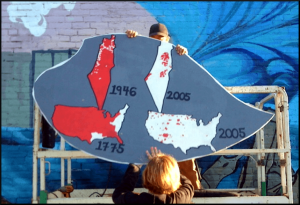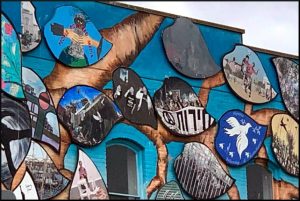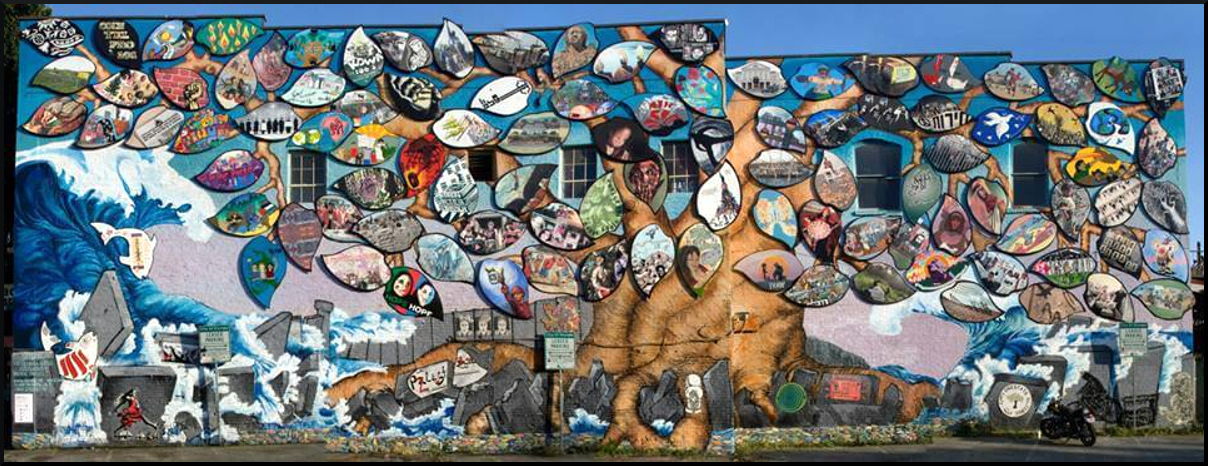By Samia Saliba, Nadia Niva, and Andrew Meyer on behalf of the Rachel Corrie Foundation for Peace & Justice and Art Forces, published on Mondoweiss, August 19, 2020
Last month, we were made aware of the targeted defacement in Olympia, Washington of a section of the Olympia-Rafah Solidarity Mural, a public art installation that was inspired by the life of Rachel Corrie. The defacement targeted one of the leaves making up the mural’s central olive tree, a leaf that was designed by artist Gail Tremblay of the Onondaga and Mi’kmaq nations in collaboration with geographer Zoltán Grossman, both of whom have taught at The Evergreen State College. The leaf depicts four maps comparing the settler colonization of Native American nations by the United States to the settler colonization of Palestinian land by Israel. This image exhibits the importance of global solidarity against settler-colonial annexation of Indigenous lands, and the targeted defacement of this leaf is an egregious act intended to silence and disrupt Indigenous solidarities.

We do not know the exact date the defacement occurred, but we estimate it was done in early May 2020, and we suspect it to be related to the Israeli government’s proposals to annex even more Palestinian territory from the West Bank. The nature of the defacement itself symbolizes the intent of the perpetrators. The comparative maps were painted over with a grey paint almost identical to the background of the leaf. This is not the sort of defacement that violently destroys or is meant to be noticed. Rather, it is a more insidious type of violence meant to erase the artistic representation into its surroundings. The violence of erasure is compounded by the fact that this specific work of art depicts the erasure of Indigenous peoples through land theft. The perpetrators of this defacement do not want us to see, internalize, and build solidarity around these erasures, but their act of desecration reinforces why we must.
Settler-colonial states are predicated on the erasure of Indigenous populations and cultures. Settler colonialism takes place first and foremost on a structural level. Unlike other forms of imperialism, where one group extracts labor and exercises power over another, settler colonialism involves erasing and rewriting the systems, hierarchies, and maps of the people who inhabited the pre-colonized land. The act of settler colonialism is one of violent extraction and displacement. The settler-colonial state must continually disavow its violent history in order to naturalize the structure in which it operates.
The mural’s desecration must also be contextualized within our local history and the mural’s history itself. This Olympia-Rafah sister city relationship was first the vision of Rachel Corrie, who often wrote about the idea while she was living in Gaza in 2003, where she joined Palestinians in non-violent direct action to end the Israeli policy of demolishing Palestinian homes. When Rachel was killed by an Israeli bulldozer in March of that year, her community carried her vision forward through the Olympia-Rafah Sister City Project and petitioned the city of Olympia to officially recognize a sister city relationship with Rafah.
The Olympia-Rafah Solidarity Mural was, in many ways, a response to the failure of local government. In April 2007, the city council voted against the sister city proposal, siding with a disingenuous yet influential minority. During public meetings, racist anti-Arab and anti-Muslim stereotypes littered public testimony offered by opponents of the sister city proposal. This was thirteen years ago, but opposition to forging a sister city relationship and desecration of the solidarity mural are connected, and they are based in the same unwillingness to accept and confront the settler-colonial present.

The defaced leaf’s map image itself has long been a focus of public attention. In 2010, the creators of the leaf and other mural artists, along with other supporters, engaged in a facilitated dialogue with community members who expressed their opposition to the message of the leaf. The Rachel Corrie Foundation and the mural committee stood then, as they do now, in support of the artist and the message of the leaf. Both in the dialogue and the defacement, it is clear that the primary opposition to the leaf stems from an unwillingness to confront the realities of settler-colonial erasure and personal responsibility in perpetuating violent erasure as settlers, be it here or in Palestine.
The disavowal of founding violence is deeply embedded in the settler mindset in both the U.S. and Israel. Descendants of settlers strive to maintain this disavowal, laboring daily to forget that their/our presence in the place they/we call home is predicated on genocide, dispossession, and structural violence. For American settlers who support Israel, this disavowal is doubled. They run from their complicity in the U.S. colonial project while simultaneously perpetuating a false narrative of Israel as acting on redemption instead of displacement, on return instead of ethnic cleansing. It is difficult to ignore connections between the settler violence of the U.S. and Israel when these states openly collaborate to build identical surveillance systems and border walls, when Israeli settlers draw explicit comparison between their settler project and the U.S.’s genocidal concept of “Manifest Destiny,” or when one sees a map that directly ties the confiscation of land in one settler state to the confiscation of land in the other. The inability to reconcile one’s own role in settler violence, in either or both places, produces the kind of emotion that might induce someone to vandalize a solidarity mural near the top of its thirty-foot tall frame. In sum, this emotion also likely drove the perpetrator to act in honor of the hallmark of the settler mindset: simultaneous erasure and disavowal.
As a community, we must continue to support Indigenous solidarities around the globe and actively organize against the erasure of history. This leaf, which in itself is just a small part of recognizing that history, will be restored by our community and will continue to stand as a reminder that both the U.S. and Israel are states predicated on settler-colonial violence. In the face of threats of continued annexation of Palestinian land, and continuing assaults on Native American sovereignty, we can look to these maps to teach us that annexation is not a one-time event, but rather a deadly, ongoing structure. The defaced leaf exemplifies the necessity of collaboration between Indigenous liberation movements and foreshadows the sort of backlash we can expect from the continuation of this important work.
As Gail Tremblay and Zoltán Grossman said in a joint statement,
“We recently saw with alarm and disgust that our art project has been defaced on a mural in downtown Olympia. The perpetrators were not protesters, but vandals evidently upset by the message of the artwork, which uses maps to compare U.S. settler colonization of Native American lands with Israeli settler colonization of Palestinian lands. We feel the desecration must be answered and corrected, and the incident be seen as an opportunity to increase awareness of common bonds between Indigenous Americans and Palestinians.
The Olympia-Rafah Solidarity Mural was dedicated was inspired by the life of Rachel Corrie, a former Evergreen student who had been crushed to death in 2003 by an Israeli military bulldozer, as she protected a Palestinian home from being demolished in Rafah, Gaza Strip. Part of the mural symbolizes an olive tree, with each ‘leaf’ provided by an artist or community group.
One of us is an artist and writer of the Onondaga and Mi’kmaq nations, and the other a Jewish geographer and son of a Hungarian Holocaust survivor. We have both taught Native Studies and our other areas of study at The Evergreen State College. On the mural leaf, we collaborated on a series of four maps that compare the diminishment of Native American lands to the diminishment of Palestinian lands, from the large majority of the territory before the independence of the U.S. and Israel, to the small reservations or enclaves remaining in the 21st century.
The maps show a similar pattern of erasing the peoples who have lived on the land for centuries. We wanted Americans who looked at the maps to see the negative effects on cultures when settlers move onto and annex land where other people have lived for centuries, and the terrible effects that land loss has on people who are driven from their villages and farms. While the histories of people’s cultural connections to place may be very different, the loss of those connections are difficult and painful.
Clearly, the number of Indigenous Americans who were killed and relocated is much larger than the number of Palestinians. But it is difficult for Indigenous people to not sympathize with Palestinians who have been dispossessed of their land and resources. It is painful to watch the ways in which Indigenous Americans and Palestinians have been dehumanized, and how Israeli and U.S. government forces have dehumanized themselves by forcibly displacing people. When people do such violence to others, it is hard to think how they are going to learn to fit into the circle of things that support life on this planet. Settler states cannot build settlements and walls on others’ lands and not cause chaos and conflict.
We are not surprised that the map leaf was defaced as Israeli Prime Minister Benjamin Netanyahu was moving (with Trump’s encouragement) to further diminish Palestinian lands through unilateral annexations. Some backers of illegal Israeli settlements have pointed to U.S. ‘Manifest Destiny’ as a precedent for the seizure and annexation of the occupied territories, in order to normalize taking Palestinians’ ancestral lands. Other backers of Israeli policy who deny its destructive effects are uncomfortable hearing about parallels with Native American history.
But centuries of Indigenous resistance here, up to current anti-racist protests, show that Native peoples do not so easily disappear through forced removal or assimilation. If the settler states are cooperating closely with each other (such as on border walls and surveillance technologies), perhaps the peoples of both lands should build bridges instead of walls, and deepen their mutual understanding.
If those who defaced the mural art think they have silenced our free speech, they have only strengthened our voices. Just as the Rachel Corrie Foundation intends to repair and restore the leaf, we intend to help renew a public understanding of settler colonial connections between the U.S. and Israel, and build stronger bonds between colonized peoples of the land.”
Gail Tremblay concluded in her longer artist’s statement on the defacement that
“[W]e must learn to move carefully, to live lightly on the planet and to share so everything stays in balance. Looking at the maps, think about O:hen:ten Karihwatehhkwen (the Words that Come Before All Else) and how we all must learn to care for one another and the Earth. Without that, there is too much greed and too much grief. I want history to stop breaking everyone’s heart and caring to become our best way of working.”
Read Gail Tremblay’s full artist statement and Zoltán Grossman’s full geographer’s statement here.
